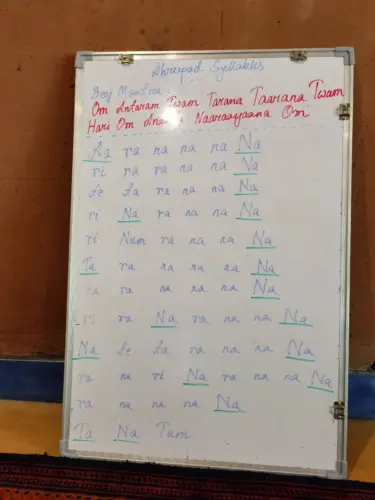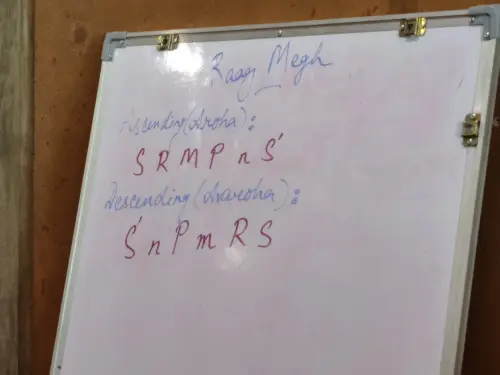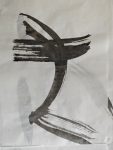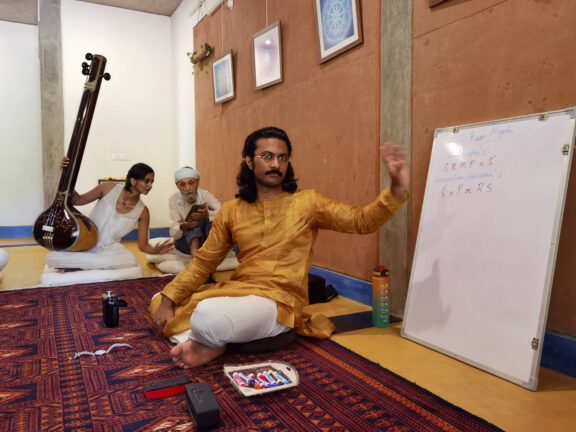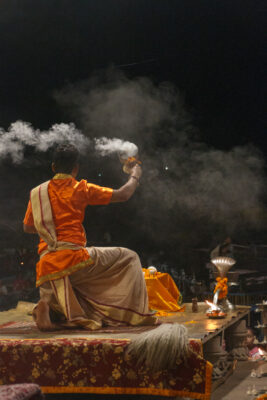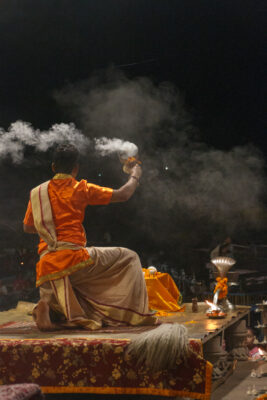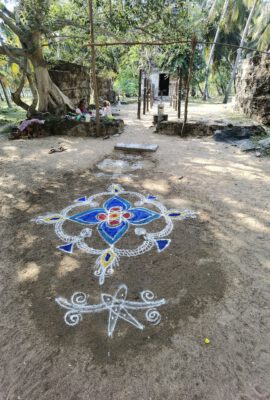II was lucky enough to attend a 3-day intensive workshop at the Sunlit Path with Niloy experience. In contrast to the tradition of slow, concentrated, dedicated learning over decades from a guru, Niloy introduced me to the world of Dhrupad. For someone like me, who is deeply drawn to this meditative and philosophical sound art, this was a gift. Dhrupad is so complex that an introduction is a good idea.
What is a sound?
Classical Western harmony divides an octave into 8 tones; if you add the semitones, there are 12. Each of these tones can serve as the fundamental tone for a scale, which in turn can be in a major or minor key. If the semitones are 'calculated' from a lower tone to a higher one, it is radiant and a major scale is created. If the semitone is calculated down from a higher one, it is slightly lower and the scale is slightly darker. Johann Sebastian Bach averaged these semitones with his well-tempered tuning of the piano, as they actually only differ in the micro-interval. The technical advantage is obvious: the piano can mirror all harmonies, the harmonic circle is implemented on the piano. As a pianist and organist, this was important to him. For the history of music, it created a harmony of pragmatism. La Monte Yung tuned the piano for a well-tuned piano again mathematically clean. When I heard that for the first time, it was an incredible liberation. All this time I had only heard music that was well-tempered and not well-tuned. But it is precisely these subtle differences that are at the heart of Dhrupad.
Nada Yoga
Nada yoga, the yoga of sound, is the exploration of sound, of tones, of vibration. Niloy told anecdotally that one of his students was a little skeptical about his ability to hear and sing micro-intervals. He brought a measuring device and on that day, a normal day for Niloy, an average day, Niloy was able to produce 17 microtones in one tone interval, i.e. hold them with his voice. For an octave with 8 tone intervals, that would be 133 micro-intervals. On another Workshop with Ustad Bahauddin Dagar, Dagar demonstrated 7 microtones in one tone interval on the Veena, which we could all understand well. However, Dagar said that he works with at least 12 microtones and that there are many more available. But not everyone can understand that. To be able to do this, the ear and the voice and the instrument must be practiced - Nada Yoga. Sharpening the senses, exploring what the world of sound has to offer the human perceptual apparatus.
Upanishads
The Kena Upanishad asks who hears when he hears, who sees when he sees, who thinks when he thinks. Who hears when 'I' hear? What is hearing? What connection does hearing create with the world? In the Upanishads, the basis of the world as we know it is vibration, physics says energy. Vibration is a vibration, matter vibrates, light vibrates, sound vibrates. Vibrations are the basis. In physics, force is not added here: gravitational force and impulse force, for example. The force of consciousness is left out. In the Vedas, forces are symbolized by cows and horses. They stand for the forces of the universe. And once you have seen a few thousand cows on India's streets, it gradually becomes clear where this image comes from.
But back to sound as a vibration, which is heard by whom? There is a vibration in the world, there is a perceptual apparatus that receives and translates this vibration and there is a consciousness that experiences it. The rishis knew that consciousness must be structurally similar to what constitutes the world and what the senses convey. How could it work otherwise? Since vibration is the basis of everything in this tradition of thought, there is of course an image and a primordial form, that is OM, the primordial sound and it is described in the Mandukia Upanishad. Nada Yoga is also about exploring this connection. The oldest tradition of doing this is Dhrupad.
Dhrupad
After these brief considerations, it is not surprising that the ragas are not notated. There is no notation system for Dhrupad. A raga is actually just a tone scale that serves as the basis for a practice. There are morning, noon and evening ragas and of course early morning and late evening and sunrise ragas, monsoon ragas and festival ragas etc. The over 3000 year old tradition of Dhrupad, the original form of classical Indian music, has been heard a lot over the millennia. Who listens while listening? What is Dhrupad? It becomes clear that it quickly becomes philosophical here.
Dhrupad is a living tradition that is passed on from teacher to student. A central element of Dhrupad is the exploration of tones, intermediate tones and the path from one tone to the next. When a monsoon raga, Rag Megh for example, forms a scale of 6 tones: Sa, Re, Ma, Pa, ni, Sa' this is the basic framework. There are countless phrasings between the notes. And instead of Sa', Re, Ma, Pa, ni, Sa, syllables can be used that are derived from the Bījamantra, for example. So it quickly becomes very complex. Learning Dhrupad is learning these countless techniques. A performance of a raga - I am reluctant to say performance, because of course we are not talking about a concert form, but about nada yoga - a performance is therefore a very structured meditation that only superficially resembles a jazz improvisation. No raga is the same.
If you now open yourself up to the world of Dhrupad, it is a completely different way of hearing. There are no right or wrong sounds. Creating a sound means producing it. Where does it come from? In singing, it starts with the breath, with the body, the sitting posture, a calm mind. Our voice is not a technical device. Making a sound is the vibration of the vocal cords. Finding the 'right' tone is a search on these vocal cords. Professionals are so fast and precise that a listener cannot hear them. But that's exactly what Dhrupad is all about. How do I produce a sound, do I approach it from below or above or from above to below? Do I circle it or hold it, do I emphasize it, draw it in or project it? So before I produce the first sound, I am actually already the mystery of the world. It's always about vibration - OM. Now that the first vibration is there, what happens next? How do I get to the next sound? What is sound? So it's not so much about the concept of music. It's nada yoga.
Language
I am naturally fascinated by the connection to language. Language is sound, mantras are knowledge in its most compact form, OM in its shortest form includes the breath, the speech apparatus, the chakras. Dhrupad traces this knowledge in the form of Nada Yoga, but is aware of its tool character. Just as pointing to something points to something and is not an end in itself (the pointing stick is not what it points to), knowledge in Dhrupad is beyond language and sound. The syllables of the Bījamantra are reduced in such a way that their linguistic reference is dissolved. What it is about cannot be expressed in language or music. The search for truth is a path, Nada Yoga one of its paths, Dhrupad its form. Dhrupad contains everything that is important, says Niloy.
You could also say it is pure deconstruction in the sense of postmodern philosophy.
